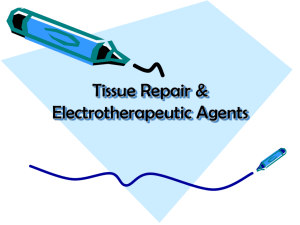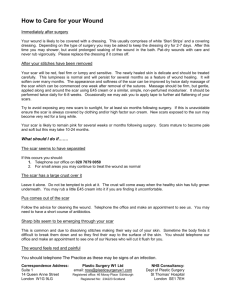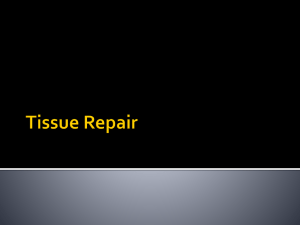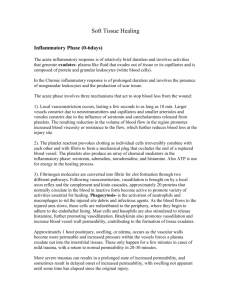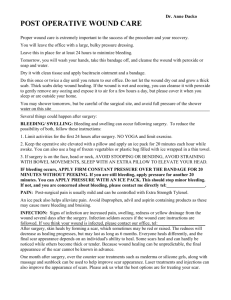Scar formation and contraction around implants
advertisement
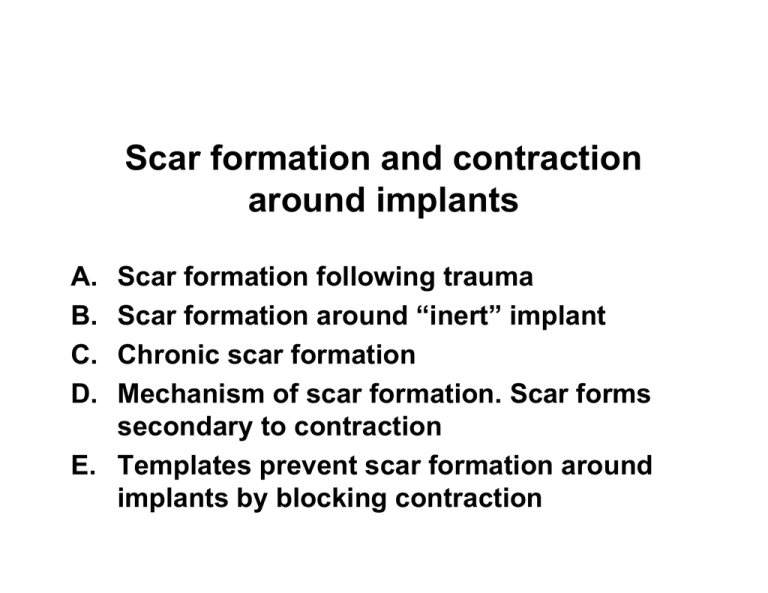
Scar formation and contraction around implants A. B. C. D. Scar formation following trauma Scar formation around “inert” implant Chronic scar formation Mechanism of scar formation. Scar forms secondary to contraction E. Templates prevent scar formation around implants by blocking contraction A. Scar formation following trauma 1. Sources of trauma: energy sources. • mechanical: deep cut, laceration, surgery • thermal: fire, hot water. • electromagnetic: UV, electrical discharge • nuclear: radiation therapy. Skin: reversible injury Figure by MIT OCW. Spontaneous regeneration of excised epidermis Left: a controlled injury (e.g. stripping or blistering) which leaves the dermis intact. Right: the epidermis recovers completely at the defect site. Hair follicles are lined with epidermal tissue and also regenerate. Skin: irreversible injury Figure by MIT OCW. Spontaneous healing of skin excised to full thickness by contraction and scar formation. The dermis does not regenerate. Left: Excision of the epidermis and dermis to its full thickness. Right: Wound edges contract and close, while scar tissue forms simultaneously in place of a physiological dermis. The epidermis that forms over the scar is thinner and lacks undulations (rete ridge). Peripheral nerve: reversible injury Mildly crushed nerve heals spontaneously by regeneration Figure by MIT OCW. Within the nerve fiber, axons and their myelin sheath are regenerative. Top: Following mild crushing injury, the axoplasm separates and the myelin sheath degenerates at the point of injury. However, the basement membrane stays intact. Bottom: The nerve fiber regenerates after a few weeks. Peripheral nerve: irreversible injury Figure by MIT OCW. Transected nerve heals spontaneously by contraction and neuroma (neural scar) formation. No reconnection of stumps. Most supporting tissues (stroma) that surround nerve fibers are not regenerative. Thus, while nerve fibers can regenerate following a transection, the other tissues in the nerve trunk cannot regenerate. After transection, the nerve trunk stumps become neuromas - clumps of scarred tissue that close largely by contraction. Severity of injury determines its reversibility Figure by MIT OCW. Scar formation following trauma (cont.) 2. Morbidity of trauma, scar formation and contraction • on finger joint it prevents movement (“contracture”) • in peripheral nerves (neuroma) it prevents conduction of electric signals (paralysis) • in neck or face it creates serious problems of social acceptance • around suture points (e.g., following caesarian section) • surgical adhesions prevent normal function of intestines or lungs (e.g.,following heart surgery) Images removed due to copyright restrictions. Poster warning NFL football players not to tackle with the crown of their helmet ("Play Heads-Up!) Diagram describing angioplasty. B. Scar formation around “inert” implant 1. Scarring following implantation of any nondegradable prosthesis (e.g., silicone, polyethylene) 2. Constrictive scar tissue (fibrous capsule) around implant causes chronic pain and implant deformation 3. Implantation of nonporous, biodegradable sheet under skin (subcutaneous) leads to encapsulation of implant by fibrotic tissue. No capsule formation around identical implant, except for being porous. 4. Implants are often supported mechanically by contraction and scar formation around them. Images removed due to copyright restrictions. Diagrams of human breast - normal and with implant. NORMAL IMPLANT C. Chronic scar formation • Scar formation and contraction result from chronic trauma; or from acute or chronic inflammation caused by various agents • Scar takes different names depending on medical specialty • Examples: 1. Scarred heart valve due to incidence of rheumatic fever leads, e.g., to valve stenosis or to leakage. 2. Necrosis (death) of myocardium (infarct) due to interruption of oxygen supply (clogged arteries) interferes with electrical conduction of heart muscle 3. Obstruction of intestinal tract, due to chronic inflammation, leads to digestive problems (e.g., duodenal ulcer with gastric outlet obstruction) 4. Fibrotic liver (cirrhosis) prevents liver function scarred heart muscle (heart attack) scarred liver (cirrhosis) scarred kidney (infection) Figure removed due to copyright restrictions. Figure 1.3 in [TORA]: Yannas, I. V. Tissue and Organ Regeneration in Adults. New York, NY: Springer, 2001. ISBN: 0387952144. scarred cornea (infection) scarred heart valve (rheumatic fever) D. Mechanism of scar formation. Scar forms secondary to contraction. 1. Macroscopic movement of tissue from periphery of wound toward center (contraction) with formation of scar near center. 2. Contractile fibroblasts (myofibroblasts, MFB) may initiate contraction; they almost certainly propagate contraction. 3. Collagen fibers in scar are highly oriented in the plane of the wound. 4. Collagen fibers synthesized by MFB and extruded outside with fiber axis parallel to long cell axis. Fiber orientation is replica of MFB axis orientation during scar synthesis. 5. Collagen fiber orientation in scar is in the plane of the wound, suggesting that MFB are in a plane stress field during scar synthesis. 6. Regeneration templates cancel out mechanical field, leading to randomization of MFB axes and fiber synthesis in random orientation. Burn patient has closed severe skin wounds in neck partly by contraction and partly by scar Final state of healing of fullthickness skin wound in the human. Photo removed due to copyright restrictions. Photo removed due to copyright restrictions. Spontaneous contraction and scar formation in burn victim Tomasek et al., 2000 Contracting skin wound. Guinea pig model. Adipose tissue layer underneath is greatly deformed by contracting wound. Natural light. Conventional histological view. Stained with H&E. S, scar. D, dermis. A, adipose tissue. Photos removed due to copyright restrictions. Viewed in polarized light stage. Collagen fibers light up. Photo removed due to copyright restrictions. Edge of full-thickness skin wound in guinea pig. E, epidermis. F, fibroblasts. B, base of wound. Scale bar, Measure C Graph removed due to copyright restrictions. Figure 4.1 in [TORA], illustrating contraction kinetics of dermis-free defect Quantitative description of healing processes • Initial wound area is Ao • Wound eventually closes up spontaneously. Final area is Af. • Final wound area is distributed among fractions that closed by contraction (%C), scar formation (%S) or regeneration (%R). • This is the configuration of the final state. • Wound closure rule: C + S + R = 100 Measurement of C, S and R in full-thickness skin wounds after wound has closed. Use only “final state” data! C S Schematic representation of two tissue blocks that have been excised following closure of a full-thickness skin wound in the guinea pig. LEFT, tissue block following wound closure by spontaneous healing. Ao, initial wound area. S, fraction of Ao which has closed by formation of scar tissue. C, fraction of Ao that has closed by contraction. RIGHT, tissue block following closure by regeneration. R, fractional coverage of Ao by regenerated skin. C, fractional coverage of Ao by contraction. Spontaneously Configuration of healing defect final state general case [C, S, R] ideal fetal healing [0, 0, 100] dermis-free skin-[96, 4, 0] adult rodents dermis-free skin-[37, 63, 0] adult human peripheral nerve– [96, 4, 0] adult rat conjunctiva-[45, 55, 0] adult rabbit Photo removed due to copyright restrictions. Final state of healing of fullthickness skin wound in the guinea pig. Orgill, 1983 Unit cell processes of scar formation • Wound healing can be summed up as a sequence comprising an inflammatory response, fibroplasia, epithelialization, wound contraction and scar maturation. The following sequence of unit cell processes is a hypothetical and highly simplified model of certain aspects of wound healing in the dermal layer. Epithelialization and scar maturation are entirely omitted in the model below: • n Platelets + Quaternary-structured collagen = [Degranulation] = Thrombus + PDGF* (and TGF-b*) _____________________________________________ • PDGF + Monocyte = [Differentiation] = Macrophage + PDGF • PDGF + Macrophage + ECM = [Collagenase** synthesis] = Solubilized ECM + Regulator • Regulator + Macrophage + Solubilized ECM = [Phagocytosis] = Degraded ECM + Regulator Unit cell processes of scar formation (Cont.) • PDGF + Fibroblast + ECM = [Mitosis] = Fibroblast proliferation + Regulator • Regulator + Fibroblast + ECM = [Synthesis] = Collagen I and III + Regulator _____________________________________________ • Composite unit cell process: Collagen synthesis + Angiogenesis = Granulation tissue _____________________________________________ • Regulator + Fibroblast + ECM = [Synthesis of α-actin] = Contractile fibroblast ("Myofibroblast") + Regulator • Regulator + Myofibroblast + ECM = [Synthesis] = Scar tissue + Regulator • Regulator + Myofibroblast + ECM = [Contraction] = Closed wound + Regulator ____________________________________________ • Wound closes up. Myofibroblasts dedifferentiate to stable fibroblasts. Myofibroblast detected with antibody to α-SM actin Figure removed due to copyright restrictions. Tomasek et al., 2000 Measure S (quantitative assay) Figure removed due to copyright restrictions. Scar is synthesized as a fiber-reinforced composite with axial orientation In the plane. Figure removed due to copyright restrictions. Image removed due to copyright restrictions. Table 4.1 in [TORA]. Developmental transition from scarless fetal to scarring (adult-type) fetal healing 1. Study of wounded fetal rats, before and after developmental transition from scarless to scarring skin wound healing. 2. Scarless healing was accompanied by decreased and rapidly cleared levels of TGFb1 and TGF-b2; also by increased and prolonged TGF-b3 levels. 3. Scarring healing was described by reversed appearance and duration of the three TGFb isomorphs. [data by Soo et al., 2003] E. Templates prevent scar formation around implants by blocking contraction 1. Differentiation of fibroblasts to the contractile phenotype requires a)TGF-b1, b) mechanical tension in the matrix, and c) presence of fibronectin fragments (ED-A fibronectin). 2. Contractile fibroblasts (myofibroblasts, MFB) contract skin wounds and nerve wounds. 3. Regeneration templates block contraction by downregulating MFB density and organization. 4. Contraction blockade by templates thwarts the adult healing response and hypothetically reactivates the dormant scarless fetal healing response (which appears to be the “default” response). Contraction blocked by scaffold (bottom) Ungrafted. Contracting vigorously. → Photo removed due to copyright restrictions. Red-brown: stained with antibody to α-SM actin. 10 d Grafted with DRT. No contraction. Photo removed due to copyright restrictions. → Troxel, 1994 Photo removed due to copyright restrictions. Active scaffold (regeneration template). Low cell density and no cell clustering. Pore size 40 µm. Photo removed due to copyright restrictions. Inactive scaffold is identical structure to active scaffold except pore size is 400 µm. High cell density and cell clustering. Closure of full-thickness skin wound in guinea pig using three protocols. KC, seeded keratinocytes. DRT, dermis regeneration template, a biologically active scaffold. Figure removed due to copyright restrictions. Partly regenerated skin KC + active scaffold Photo removed due to copyright restrictions. Photo removed due to copyright restrictions. KC + inactive scaffold Scar Photo removed due to copyright restrictions. Full-thickness skin wound (guinea pig) grafted with keratinocytes (KC) seeded in an active or inactive scaffold Orgill, 1983 Kinetics of skin wound contraction in guinea pig using three protocols. KC, seeded keratinocytes. DRT, dermis regeneration template. Courtesy of National Academy of Sciences, U.S.A. Used with permission. (c) National Academy of Sciences, U.S.A. Source: Yannas, I., et al. "Synthesis and Characterization of a Model Extracellular Matrix that Induces Partial Regeneration of Adult Mammalian Skin." PNAS 86 (1989): 933-937. Images removed due to copyright restrictions. rete ridges ↑ ↑ capillary loops capillary loops Normal skin. Burkitt et al., 1992 Regenerated skin, swine. Compton et al., 1998 Data illustrating use of active scaffolds in 3 organs Organ/ Treatment species used Skin/guinea pig scaffold DRT Spontaneous healing [91, 9, 0] Treated Skin/guinea pig scaffold DRT+ KC [92, 8, 0] [28, 0, 72] Conjunctiva/ rabbit Nerve/rat scaffold DRT [45, 55, 0] [13, 0, 87] silicone tube+scaffold NRT collagen tube+scaffold NRT [95, 5, 0] [53, 0, 47] [95, 5, 0] [0, 0, 100] Nerve/rat [89, 0, 11] Data reviewed in Yannas, 2001
